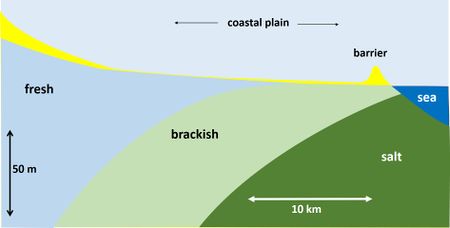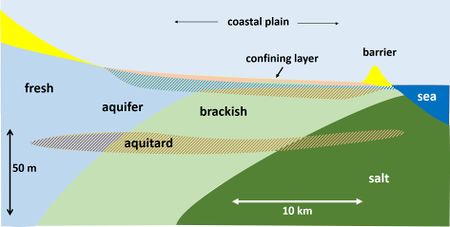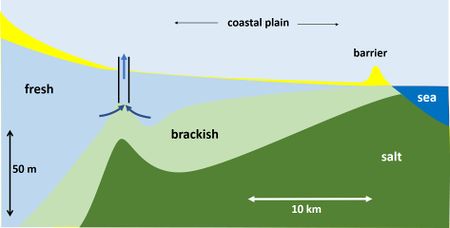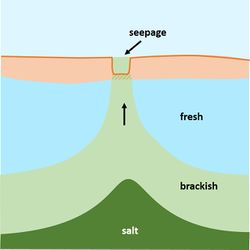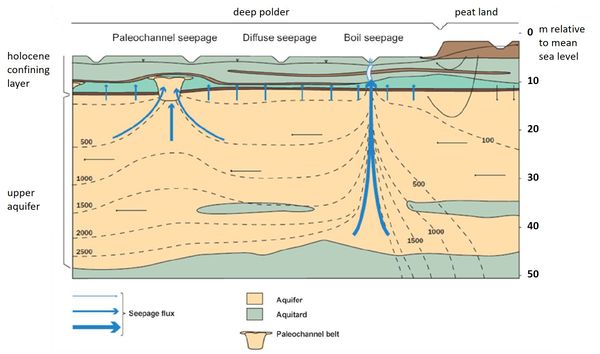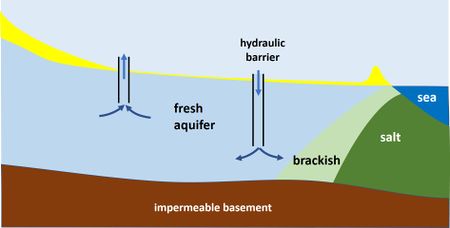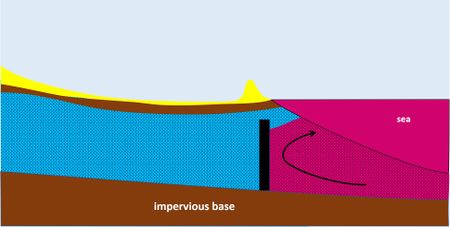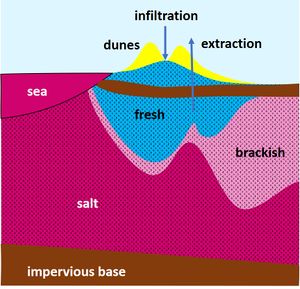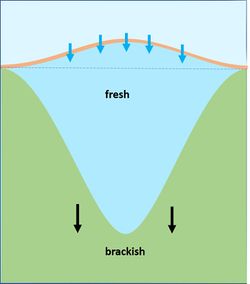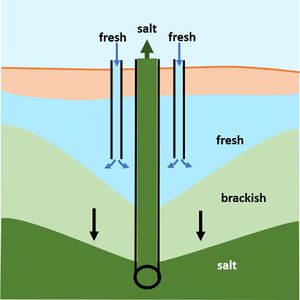Testpage4
Groundwater management in low-elevation coastal zones
Groundwater management is a major issue in many low-lying coastal areas. This article focuses on shallow coastal aquifers connected to the sea.
Contents
Development in low-lying coastal plains
The topography of low-lying coasts generally consists of a coastal barrier (dune, protruding rock, elevated deposit) backed by a coastal plain with elevation close to the sea level: a wetland, a (partly) reclaimed lagoon or a sabkha. The coastal plain constitutes a low-energy environment in which fine sediments (clay, silt) have been deposited and where under humid climate conditions abundant plant remains have formed peat layers. Low-lying coastal plains are therefore usually characterized by a poorly permeable upper soil layer from a few meters to several tens of meters thick. This upper soil layer has a low load-bearing capacity.
Many large coastal cities have expanded into these low plains in recent decades, see Coastal cities and sea level rise. Other parts of the coastal plain mainly serve as agricultural land. The demand for freshwater has increased sharply due to the strong population growth in coastal areas. At the same time, the water supply from the hinterland has decreased due to an increased water demand in the upstream catchment areas. Water scarcity is therefore an urgent problem in many coastal areas. The highest water demand is generally related to irrigation needs. To meet this water demand, groundwater is pumped up in quantities that are larger than the replenishment of the groundwater layer. The following sections describe what the impacts are, how they come about and what measures can be taken.
Impact of groundwater extraction
The massive extraction of groundwater in many coastal areas without sufficient recharge has serious consequences:
- Increasing seawater intrusion into the subsurface groundwater. This can remain unnoticed for some time because groundwater flow is a slow process. In the long run, however, the groundwater will become saline and unfit for crop irrigation. Evapotranspiration of irrigation water can cause a further increase of the soil salinity and the groundwater. Saline groundwater degrades the foundations of buildings by attacking bricks, concrete and the steel reinforcement.
- Soil subsidence by compaction when water is extracted from underlying clay or peat layers. In urbanized areas, this compaction is exacerbated by the weight of buildings. The upper boundary of the seawater wedge in the subsurface therefore rises. Crops die when the roots are in contact with salt water and ecosystems are degraded. Moreover, the risk of flooding from the sea increases. It is estimated that worldwide about half a billion people live in subsiding delta areas[1].
Soil salinization is not only a problem in coastal areas. IPBES (2018) [2] suggests that worldwide around 76 million hectares of mostly irrigated land has been permanently lost by salinization and can no longer be farmed, with a further 60 million hectares damaged. Coastal areas are particularly vulnerable because of intensive groundwater use and associated increased seawater intrusion related to the demand of a fast growing population. This vulnerability is exacerbated by the effects of climate change; a higher relative sea level, increase of evapotranspiration, more frequent droughts and declining river runoff to the coast increase soil salinization.
Salt intrusion processes
Seawater intrudes into the underground of the coastal plain through [aquifer]s, permeable soil layers consisting of medium / coarse granular material or fissured rock. It pushes fresh water higher inland due to its greater density. A counter-pressure is exerted by the fresh water table in the unsaturated inland zone situated above sea level. Due to the small density difference, a small elevation of the fresh water head is sufficient to keep the seawater intrusion in balance. An increase in the freshwater head of 1 m is sufficient to push the seawater wedge into the subsoil about 40 m downwards. The equilibrium situation is shown schematically in Fig. 1. In this figure it is assumed that the permeability of the underground is the same everywhere. In reality, however, this is never the case due to the presence of poorly permeable layers (aquitards); Fig. 2 shows a still much simplified but slightly more realistic image.
Seawater intrusion depends on the elevation difference between the inland fresh water table and the water level at sea. The sea level is variable due to tidal motion and wind set-up / set-down and the inland fresh water table varies over the seasons in response to variable fresh water runoff. These fluctuations in the groundwater pressure gradient contribute to mixing across the fresh-salt interface (REF?). Sea level rise is an ongoing trend that gradually increases the seawater intrusion into the underground. Shoreline retreat associated with sea level rise can also play a role. Seawater intrusion is further enhanced in case of a trend-wise decrease of the fresh groundwater flux to the coast and increasing abstraction of groundwater without equivalent fresh water recharge.
In some cases, the coastal barrier cannot prevent flooding of the coastal plain from the sea under extreme circumstances. The seawater infiltrates from the surface into the groundwater, which therefore becomes saline and unsuitable for use. The seawater diffuses slowly into the groundwater, where increased salinity levels are maintained for a long time [3].
When no fresh water is present in the subsoil, as is often the case in arid coastal plains, crops must be irrigated with water that is supplied from elsewhere. Due to water scarcity, the infiltrated irrigation water is collected in special drains and re-used for irrigation. Such an irrigation system exists, for example, in the Nile Delta [4]. Because the irrigation water is mixed with brackish groundwater, re-use causes, in combination with evapotranspiration, a net salt flux to the land surface.
Groundwater flows very slowly, often no more than a few meters per year or even less. The flow rate depends linearly on the product of pressure gradient and permeability. The permeability, often expressed as hydraulic conductivity, is usually very low. This means that the effect of groundwater extraction or infiltration is initially localized and will only be felt at greater distance after a long period. It also means that large pressure gradients can occur, associated with a steep slope of the salt-fresh interface. When pumping up groundwater, salt groundwater can therefore easily rise from great depths, see Fig. 3. This effect is termed 'upconing'. The same happens when groundwater seeps through a passage (a discontinuity, crack, ditch) in a confining upper layer, as shown in Fig.4.
In low-lying coastal plains situated below sea level saline intrusion into the upper soil layer is a major issue, even in countries with rainfall excess. Saline water can rise to the surface by different processes (see Fig. 5): (1) diffuse seepage of saline groundwater in case of a semipermeable upper layer; (2) preferential saline seepage through sandy paleochannel belts in the confining layer and (3) intense seepage via localised boils in waterways or on the land (De Louw et al., 2010[5]). The highest concentration of saline groundwater is found at boils through which groundwater preferentially discharges at high velocities, thereby resulting in upconing of deeper and more saline groundwater. In many deep polders, the salinity of the surface water system is therefore largely determined by these saline boils (De Louw, 2013 [6]). Where rainwater or fresh surface water supplies are limited, saline seepage leads to salinization of surface water and shallow groundwater in contact with the root zone - a process known as internal salinization.
Groundwater management
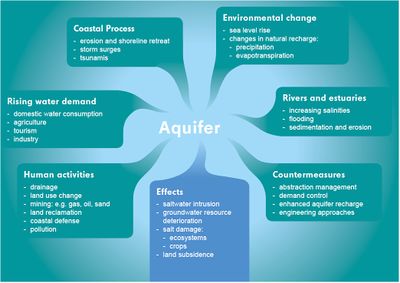
Groundwater management requires an integrated approach based on insight into the multiple factors that influence the groundwater system, see Fig. 6. This insight is usually fragmentary due to the complexity of the groundwater system. The minimum required knowledge consists of an inventory of all existing wells, the quantity and quality of the abstracted water and its destination. From the analysis of these data, supplemented with hydrogeological data of groundwater recharge, the influence of the use on the groundwater status can be estimated. Permits, metering of wells, quotas and water taxes are the legal instruments on which sustainable groundwater management can be based, together with obligations of monitoring and reporting. Polluting substances from point sources (industrial effluents, household sewage) and from diffuse sources (agricultural effluents containing pesticides, herbicides, fertilizers) are a major danger for groundwater contamination. Adequate environmental policy, agricultural policy, and spatial policy that tackle the pollution issue are prerequisite for sustainable groundwater management. The effectiveness of groundwater management can be increased by involving local stakeholders, due to the strong link between use and usability of the groundwater system. Understanding and support from stakeholders makes it easier to enforce legal rules and provisions. Without support of stakeholders, enforcement is usually difficult to achieve [7].
Monitoring aquifers is a technically demanding and costly exercise so that information about many aquifers is often incomplete. The costs for setting up a monitoring network, collecting data regularly, processing, interpreting, and storing it in databases, including unified databases at the national level, are one of the reasons why in developed and developing countries alike water rights and monitoring obligations, especially with respect to groundwater, may remain unimplemented [7].
Measures to combat salt intrusion
Different types of measures are possible to combat salt intrusion, which can be applied depending on the geological setting and the causes of salt intrusion.
1. If sufficient fresh water is available, due to precipitation or river supply, salt water can be flushed back to the sea. The intrusion of seawater into rivers will be counteracted if the river discharge is sufficiently large. The effectiveness of river flushing depends on the bathymetric characteristics of the estuary, as discussed in Seawater intrusion and mixing in estuaries. Salinization of shallow groundwater in the coastal plain can be prevented by installing drainage channels (ditches) that are flushed with rainwater or with water that is supplied from nearby rivers. Groundwater abstraction in periods of drought must be compensated by equivalent fresh water recharge during wet periods, by precipitation or by fresh water supply from elsewhere. This allows a fresh (rain)water lens to be maintained in the upper groundwater layer.
2. If the freshwater availability for the above measures is insufficient, other interventions to counteract seawater intrusion can be considered, depending on the structure of the substrate. If fresh water is available during sufficiently long and frequent periods, a hydraulic barrier can be created in the upper aquifer. The hydraulic barrier consists of a freshwater injection system that repels seawater from the upper aquifer near the sea. Further inland, freshwater can be extracted in periods of drought (to a limited extent) from the fresh aquifer, see Fig. 7. A practical example is the hydraulic barrier installed in California near Los Angeles [8]. Another possibility is the creation of a physical barrier in the upper aquifer near the sea boundary, e.g. by injecting concrete, see Fig. 8. Such interventions has been implemented in Shandong province on the Bohai Sea in China [9].
3. Areas subject to strong salt seepage can be isolated by adjusting the intake, discharge, storage and drainage systems. This requires identifying the saline drainage level areas and building a bypass around it to isolate the saline area and prevent it from being used during dry periods. This system can be further optimized through dynamic operational management of drainage, fresh water intake, and temporary storage of saline seepage water based on weather forecasts and real-time monitoring of salt concentrations at strategic locations in the polder. Automatic weirs can easily control the temporary isolation of drainage level areas with a significant number of boils during dry periods. The temporarily stored salt water can then be discharged during rainstorm events when salt concentrations are low.
Field research has shown that sealing naturally occurring boils (which arise from the heaving and cracking of the confining layer) is very difficult and cannot be achieved with current technologies [10]. This is because in general a relatively large area (about 20 by 20 metres on average) is affected by the heaving and cracking of the confining layer, rendering the area unstable and riddled with cracks. Boil sealing fairly quickly leads to development of new boils in existing cracks in the unstable boil area. Boil sealing has proved to be much simpler and more promising for boils which arise from the removal of structures, such as level filters or sheet piles, or from the sealing of old gas wells. This can be achieved in two ways: through injection of expanding and persisting fluids or biosealing. If expanding and persisting gels are used, it is advised to use an environmentally friendly gel. Biosealing is by definition environmentally friendly.
4. Creation of fresh water reservoirs below elevated sandy deposits. In low-lying coastal areas, sandy deposits are often present, in particular a dune belt along the coast, but also sand deposits in paleochannels that rise above the mean ground level. A large underground freshwater reservoir can be created by infiltrating fresh water into these sand deposits. The explanation for this is the small difference in density between freshwater and seawater, which, however, is large enough to prevent the mixing of freshwater and seawater. As a result, a large column of fresh water can be in hydrostatic equilibrium with surrounding seawater. An example of freshwater infiltration in a dune area is shown schematically in Fig. 9. The use of freshwater infiltration in a paleochannel deposit protruding above land is shown schematically in Fig. 10.
5. Creation of a fresh water lens by fresh water infiltration and lowering of the brackish groundwater table [11]. Salt groundwater is pumped away from greater depth to reduce the hydrostatic pressure on the surface layer. This can prevent an existing freshwater lens from being pushed out. The salty water is discharged (possibly via the river) to the sea via separate drains. A freshwater lens can also be enlarged or created by injecting fresh water supplied from elsewhere. The extraction-injection is operated by a so-called automatic 'freshmaker' system. The principle is shown schematically in Fig. 10.
Dealing with brackish groundwater
In arid coastal zones with endemic freshwater shortages, there are no good options for combating salt intrusion in groundwater. Strict regularization of groundwater abstraction is necessary to make land use possible. Agriculture has to make use of salt-tolerant crops. Ever better crops are being developed for saline conditions, including by genetic modification techniques. In addition, infrastructure must be protected against corrosion by saline groundwater, including the use of salt-resistant concrete.
Groundwater modelling
Groundwater flow can be described with Darcy's law, which couples the flow rate linearly to the gradient in the hydrostatic groundwater pressure. The crucial problem is the determination of the coupling coefficient, the so-called hydraulic conductivity. This coefficient is different for each soil type. The structure and composition of the substrate is generally very complex. It is a reflection of the geological history in which a large number of processes on very diverse space and time scales play a role. The reliability with which groundwater flows can be simulated therefore depends primarily on the extent to which the structure and composition of the subsoil is known. This knowledge usually has large gaps, since sampling the subsurface over great depth requires a great deal of effort and is very expensive. Missing knowledge of the subsurface can be partially overcome by model calibration based on data from wells, piezometric surveys (groundwater pressure) and observations based on geophysical techniques.
In recent decades, a large number of geophysical measurement methods have been developed that indirectly provide information about the structure and properties of the subsurface and groundwater[12] . These are in particular: Seismic techniques, such as Ground Penetrating Radar (GPR [13][14]); Nuclear Magnetic techniques, such as Magnetic Resonance Sounding (MRS [15]), Time Lapse Gravity (TLG [16]); Electromagnetic techniques [17], such as Time Domain Electromagnetic sounding (TDEM [18]) and Induced Polarization (IP [19]). Most of these techniques can be applied on the ground or air-borne. They provide indirect data on, among other things, the structure of the subsurface, the location of the salt-fresh transition, the groundwater flow, and salinity, which together with information from wells, bore holes and model calculations enable reasonable estimates of the effect of interventions in the groundwater system. However, the design of groundwater models and the interpretation of model results still require highly specialized knowledge and experience of geohydrological processes.
References
- ↑ Syvitski, J. P., Kettner, A. J., Overeem, I., Hutton, E. W., Hannon, M. T., Brakenridge, G. R. and Nicholls R. J. 2009. Sinking deltas due to human activities. Nature Geoscience 2: 681-686
- ↑ IPBES 2018. The IPBES assessment report on land degradation and restoration. Intergovernmental Science-Policy Platform on Biodiversity and Ecosystem Services
- ↑ 3.0 3.1 Post, V.E.A., Eichholz, M. and Brentführer R. 2018. Groundwater management in coastal zones. Bundesanstalt für Geowissenschaften und Rohstoffe (BGR). Hannover, Germany, 107 pp.
- ↑ Kotb, T.H.S., Watanabe, T., Ogino, Y. and Tanji, K.K. 2000. Soil salinization in the Nile Delta and related policy issues in Egypt. Agricultural Water Management 43: 239-261
- ↑ De Louw, P.G.B., Oude Essink, G.H.P., Stuyfzand, P.J. and Van der Zee, S.E.A.T.M. 2010. Upward groundwater flow in boils as the dominant mechanism of salinization in deep polders, The Netherlands. Journal of Hydrology 394: 494-506
- ↑ De Louw, P.G.B. 2013. Preferential seepage via boils and interactions between shallow rainwater lenses and saline seepage. Thesis, Vrije Universiteit Amsterdam
- ↑ 7.0 7.1 Mechlem, K. 2016. Groundwater Governance: The Role of Legal Frameworks at the Local and National Level—Established Practice and Emerging Trends. Water 2016, 8, 347; doi:10.3390/w8080347
- ↑ Johnson, T. 2007. Technical Documents on Groundwater and Groundwater Monitoring Battling Seawater Intrusion in the Central and West Coast Basins. WRD Technical Bulletin 13. http://www.wrd.org/engineering/reports/TB13_Fall07_Seawater_Barriers.pdf
- ↑ Ishida, S., Tsuchihara, T., Yoshimoto, S. and Imaizumi, M. 2011. Sustainable use of groundwater with underground dams. In: Japan Agricultural Research Quarterly 45: 51-61
- ↑ De Louw, P.G.B., Doornenbal, P. and Hendriks, D.M.D. 2012. Field research on boil sealing. Deltares-report 1201949-000, 52pp. [in Dutch]
- ↑ Zuurbier, K. G., Kooiman, J. W., Groen, M. M., Maas, B. and Stuyfzand, P. J. 2014. Enabling successful aquifer storage and recovery (ASR) of freshwater using horizontal directional drilled wells (HDDWs) in coastal aquifers. In: Journal of Hydrologic Engineering 20 (3), B4014003
- ↑ Herckenrath, D. 2012. Informing groundwater models with near-surface geophysical data. Thesis, Technical University of Denmark
- ↑ Knight, R. 2001. Ground penetrating radar for environmental applications. Annual Review of Earth and Planetary Sciences 29L 229-255
- ↑ Huisman, J., Hubbard, S., Redman, J. and Annan, A. 2003. Measuring Soil Water Content with Ground Penetrating Radar: A Review. Vadose Zone Journal 2: 476-491
- ↑ Legchenko, A., Baltassat, J. M., Beauce, A. and Bernard, J. 2002. Nuclear magnetic resonance as a geophysical tool for hydrogeologists. Journal of Applied Geophysics 50: 21-46
- ↑ Montgomery, E.L. 1971. Determination of coefficient of storage by use of gravity measurements: Ph.D. dissertation, University of Arizona, Tucson, 144 p
- ↑ Macaulay, S. and Mullen, I. 2007. Predicting salinity impacts of land-use change: Groundwater modelling with airborne electromagnetics and field data, SE Queensland, Australia, International Journal of Applied Earth Observation and Geoinformation 9: 124-129
- ↑ Auken, E., Christiansen, A. V., Jacobsen, L. H. and Sorensen, K. I. 2008. A resolution study of buried valleys using laterally constrained inversion of TEM data. Journal of Applied Geophysics 65: 10-20
- ↑ Dahlin, T., Leroux, V. and Nissen, J. 2002. Measuring techniques in induced polarisation imaging. Journal of Applied Geophysics 50: 279– 298
